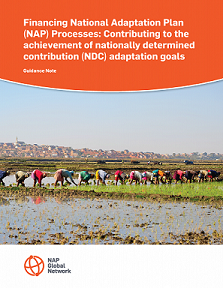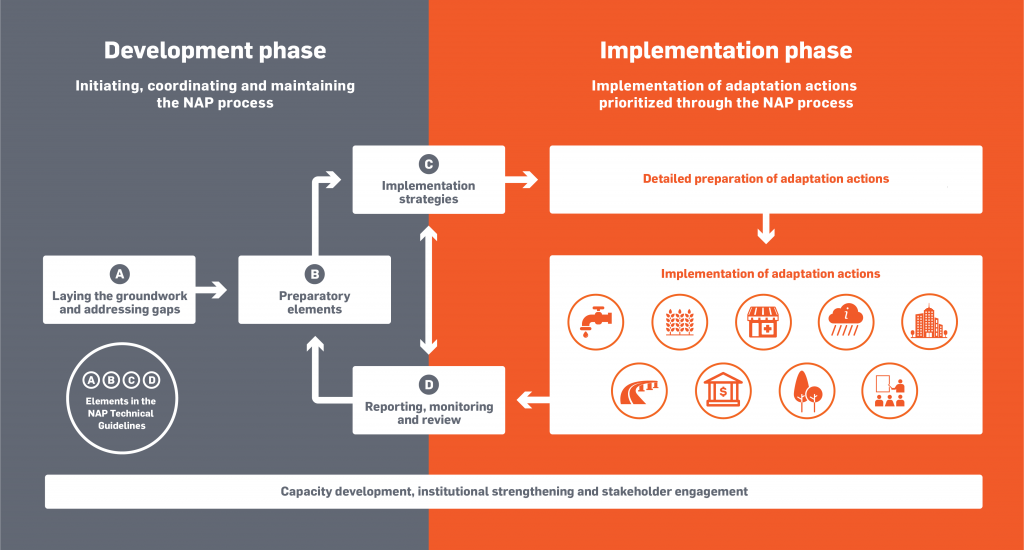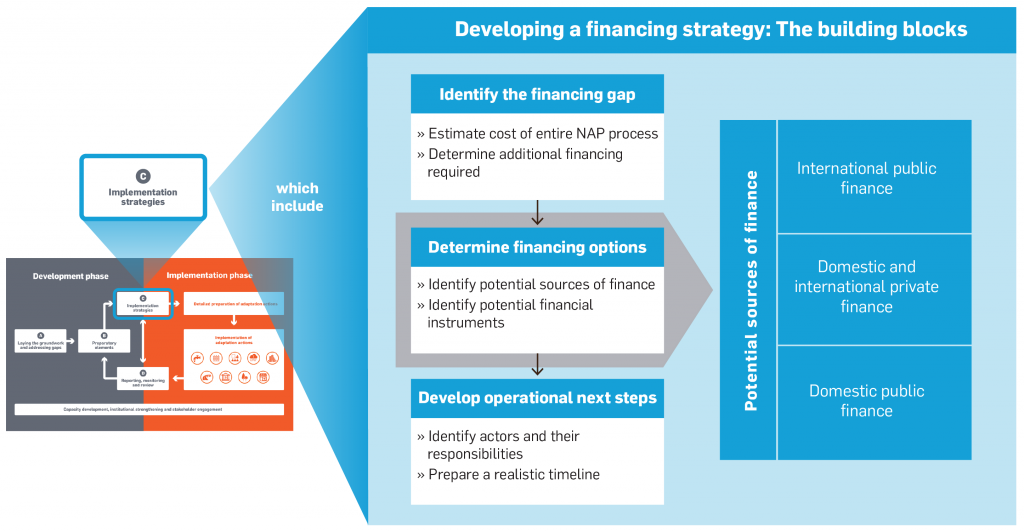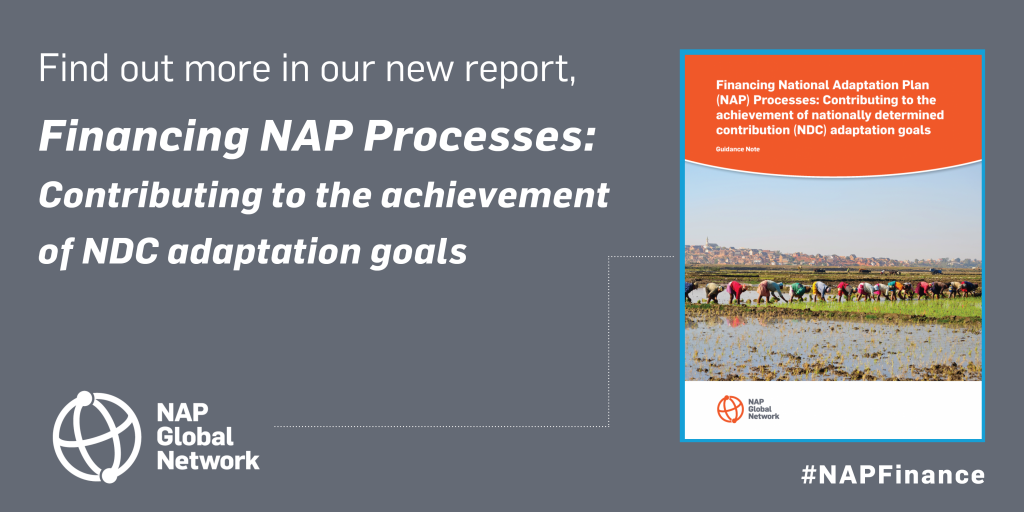Introduction
 Significant financing is needed throughout the National Adaptation Plan (NAP) process—from its inception and coordination through to the implementation and monitoring of prioritized adaptation actions. Financing is especially required within its implementation phase.
Significant financing is needed throughout the National Adaptation Plan (NAP) process—from its inception and coordination through to the implementation and monitoring of prioritized adaptation actions. Financing is especially required within its implementation phase.
Most countries will need to combine a range of potential sources of finance—private and public, international and domestic—to achieve the adaptation ambitions determined through their NAP processes.
Just as there is no one-size-fits-all approach to the NAP process in general, there is also no single approach to financing this process. Countries need to carefully consider which sources of financing may be appropriate to meeting their individual financing needs at different phases of the NAP process. They should also be aware of how actions taken during the NAP process could increase their likelihood of securing finance from different sources in the future.
Our new guidance note Financing NAP Processes: Contributing to the achievement of nationally determined contribution (NDC) adaptation goals—co-authored by Deutsche Gesellschaft für Internationale Zusammenarbeit (GIZ) GmbH’s Climate Policy Support Program and the International Institute for Sustainable Development—explores a range of financing options, highlighting the suitability of different sources for different contexts. Among our key recommendations is that countries create a dedicated NAP financing strategy to more strategically align financing needs for the NAP process with potential sources of finance.
Four main sources of financing can be considered by countries’ NAP teams when developing a NAP financing strategy.
1. Finding money for adaptation in the national budget
Although finding money for NAP processes in domestic budgets can be challenging, they are still a crucial source of financial resources. Domestic finance often is needed to support the ongoing coordination of the NAP process and facilitation of adaptation planning. It can also be a source of financing for the implementation of prioritized adaptation actions.
A demonstrated commitment to the NAP process in the national budget can be an important step towards leveraging more public and private investment. Domestic public finance is also a relatively predictable and flexible source of finance for both the development and implementation phases of the NAP process. It also provides a means by which to allocate finance to subnational actors expected to play a significant role in implementing planned adaptation actions.
Where funds are lacking, governments can consider a number of ways in which to generate new revenue for the NAP process. They can, for example:
- Create new taxes, levies and fees
- Issue bonds, including those tailored to the country’s diaspora community
- Negotiate with a country’s creditors to have a portion of their debt cancelled to release funds for use for prioritized adaptation actions
The suitability of these options will vary depending on a country’s circumstances. Governments should take into consideration factors such as their capacity to properly design and implement these fiscal instruments before introducing them.
Countries can also redistribute existing or new government revenue to achieve desired adaptation outcomes. For example, by reforming subsidies for gasoline, the Indonesian government saved IDR 120 trillion (USD 8.9 billion) for use in village funds, agriculture, education, infrastructure and other areas that can be expected to increase adaptive capacity.
See page 11 of our guidance note for more on domestic public finance options.
2. Leveraging available support from bilateral development partners
Bilateral funding—public funds provided by one country to another—can be a flexible source of finance for a whole range of costs associated with both the development and implementation phases of the NAP process.
Bilateral support can be particularly useful when countries wish explore innovative approaches to adaptation, and for enabling activities such as capacity development and the strengthening of institutions and systems for adaptation.
For example, Grenada and its bilateral partner, the German Federal Ministry for the Environment, Nature Conservation, Building and Nuclear Safety (BMUB), created the Integrated Climate Change Adaptation Strategies (ICCAS) program. It aims to increase the resilience of Grenada’s vulnerable communities and ecosystems to climate change. Among this program’s successes to date, it has helped integrate adaptation into national development planning and identify national adaptation priorities.
Bilateral funding does have its limits, however. Countries’ ability to leverage bilateral assistance will depend in part on their existing relationships with bilateral providers and the extent to which these providers emphasize adaptation in their funding strategies. For bilateral assistance to be an effective source of finance for the NAP process, it is also critical to ensure coordination of donors’ support to avoid duplication of efforts.
See page 21 of our guidance note for more on bilateral providers.
3. Accessing multilateral providers
The international community has established several multilateral funds, both under and outside of the United Nations Framework Convention on Climate Change that can finance aspects of the NAP process. This diverse range of multilateral funds are described in detail starting on page 24 of our guidance note.
Significant funding of the development and implementation phases of the NAP process is available through these sources. Notably, the Green Climate Fund now offers up to USD 3 million in funding to support the development phase of the NAP process. It also has committed half of its overall funding to projects and programs that advance adaptation efforts that are consistent with strategies and plans such as those emerging from NAP processes.
That said, the transaction costs associated with accessing multilateral funding in comparison to the needs of individual projects should be considered. It can often take more than two years to move a project from the idea stage to implementation. The funding modalities of different multilateral funds also need to be well understood. A NAP financing strategy, therefore, should carefully consider which funds are the best fit for a country’s needs.
Multilateral development banks also can help finance a country’s NAP process, particularly its implementation phase. They can both directly provide significant finance and catalyze additional funds from public and private resources. Multilateral development banks may be especially well suited to financing prioritized adaptation actions in sectors that they have a track record of financing, such as the agriculture, built environment, energy, infrastructure and transport sectors. They may also be more suited to financing large-scale projects.
See page 24 of our guidance note for more on multilateral providers.
4. Engaging the private sector
Given the amount of finance that is needed by NAP processes, public sector finance alone will not be enough. As such, there is growing interest in understanding how to mobilize private sector involvement in NAP processes, especially to meet the gap in financing for the implementation phase.
Private financiers, such as commercial banks and microfinance institutions, can directly provide financing to governments and other private sector actors to enable implementation of prioritized adaptation actions. Governments can use public finance to catalyze these private financial flows, such as through public-private partnerships.
The public sector can also promote investment by private enterprises in adaptation actions. Private enterprises can be encouraged to invest in innovative products and solutions needed by all sectors to adapt to climate change. By integrating climate risk into their own operations, they can also reduce climate-related risks to their businesses.
NAP teams should have a clear idea of the diverse range of private financiers and private enterprises within their country to develop effective strategies for engaging them in the NAP process. They can then encourage domestic private investments by building awareness of the business case for financing adaptation actions or providing access to non-financial incentives like climate data and capacity-building opportunities.
See page 31 of our guidance note for more on engaging the private sector.
Building blocks for a NAP financing strategy
A dedicated financing strategy for the NAP process can help ensure a planned, coordinated and coherent approach to identifying and securing finance needed at different stages of the NAP process. It should preferably be developed early in the NAP process and identify the scale of financing required and the sources of financing that best fit a country’s specific adaptation needs.
The NAP process is an important vehicle for countries to move beyond financing one-off adaptation projects to a more programmatic and integrated approach.
By carefully considering how to sustainably finance the NAP process, NAP teams can help realize national adaptation ambitions that are being set out in not just national adaptation plans, but also in nationally determined contributions and the Sustainable Development Goals.
Download the publication: Financing NAP Processes: Contributing to the achievement of NDC adaptation goals


